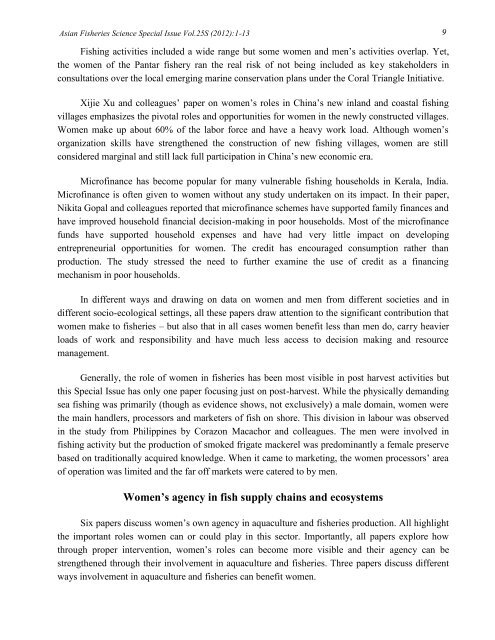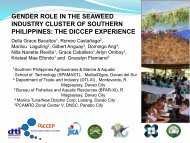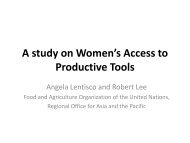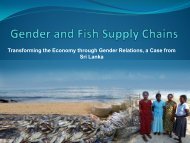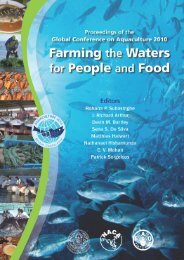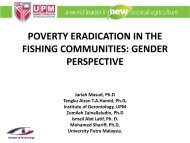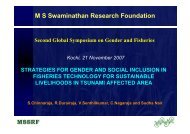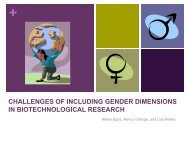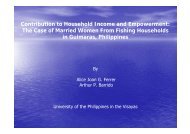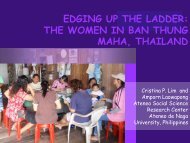Moving the Agenda Forward - GENDER IN AQUACULTURE AND ...
Moving the Agenda Forward - GENDER IN AQUACULTURE AND ...
Moving the Agenda Forward - GENDER IN AQUACULTURE AND ...
Create successful ePaper yourself
Turn your PDF publications into a flip-book with our unique Google optimized e-Paper software.
Asian Fisheries Science Special Issue Vol.25S (2012):1-13 9Fishing activities included a wide range but some women and men’s activities overlap. Yet,<strong>the</strong> women of <strong>the</strong> Pantar fishery ran <strong>the</strong> real risk of not being included as key stakeholders inconsultations over <strong>the</strong> local emerging marine conservation plans under <strong>the</strong> Coral Triangle Initiative.Xijie Xu and colleagues’ paper on women’s roles in China’s new inland and coastal fishingvillages emphasizes <strong>the</strong> pivotal roles and opportunities for women in <strong>the</strong> newly constructed villages.Women make up about 60% of <strong>the</strong> labor force and have a heavy work load. Although women’sorganization skills have streng<strong>the</strong>ned <strong>the</strong> construction of new fishing villages, women are stillconsidered marginal and still lack full participation in China’s new economic era.Microfinance has become popular for many vulnerable fishing households in Kerala, India.Microfinance is often given to women without any study undertaken on its impact. In <strong>the</strong>ir paper,Nikita Gopal and colleagues reported that microfinance schemes have supported family finances andhave improved household financial decision-making in poor households. Most of <strong>the</strong> microfinancefunds have supported household expenses and have had very little impact on developingentrepreneurial opportunities for women. The credit has encouraged consumption ra<strong>the</strong>r thanproduction. The study stressed <strong>the</strong> need to fur<strong>the</strong>r examine <strong>the</strong> use of credit as a financingmechanism in poor households.In different ways and drawing on data on women and men from different societies and indifferent socio-ecological settings, all <strong>the</strong>se papers draw attention to <strong>the</strong> significant contribution thatwomen make to fisheries – but also that in all cases women benefit less than men do, carry heavierloads of work and responsibility and have much less access to decision making and resourcemanagement.Generally, <strong>the</strong> role of women in fisheries has been most visible in post harvest activities butthis Special Issue has only one paper focusing just on post-harvest. While <strong>the</strong> physically demandingsea fishing was primarily (though as evidence shows, not exclusively) a male domain, women were<strong>the</strong> main handlers, processors and marketers of fish on shore. This division in labour was observedin <strong>the</strong> study from Philippines by Corazon Macachor and colleagues. The men were involved infishing activity but <strong>the</strong> production of smoked frigate mackerel was predominantly a female preservebased on traditionally acquired knowledge. When it came to marketing, <strong>the</strong> women processors’ areaof operation was limited and <strong>the</strong> far off markets were catered to by men.Women’s agency in fish supply chains and ecosystemsSix papers discuss women’s own agency in aquaculture and fisheries production. All highlight<strong>the</strong> important roles women can or could play in this sector. Importantly, all papers explore howthrough proper intervention, women’s roles can become more visible and <strong>the</strong>ir agency can bestreng<strong>the</strong>ned through <strong>the</strong>ir involvement in aquaculture and fisheries. Three papers discuss differentways involvement in aquaculture and fisheries can benefit women.


